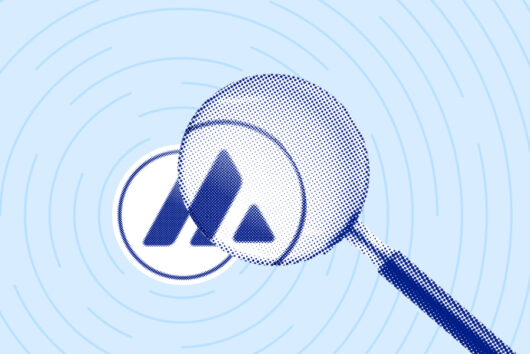What is Avalanche?


Avalanche (AVAX) is a platform that uses smart contracts to facilitate a wide variety of digital applications, including tokenised assets, stablecoins, decentralised finance (DeFi) protocols such as lending, and NFTs.
The ultimate goal of the Avalanche team is to build a platform that hosts all of the world’s digitised assets. Founder Emin Gün Sirer explained his vision for Avalanche in an interview:
“Everything we buy and sell has to be backed by a token and asset identifier on a blockchain. This certainly goes for every virtual asset, every financial asset, every piece of commercial paper, every single loan… But it also goes for all of the machines and so forth that we buy. My car should be something that I authenticate on the blockchain.”
Avalanche claims to be able to do this by being faster and more scalable than competitors like Ethereum, as well as enabling developers to create their own custom networks to build their apps on that best suit their needs.
Takeaway

Learn more
What is Avalanche’s cryptocurrency?
How are transactions confirmed on Avalanche?
The three blockchains powering the Avalanche ecosystem
What is Avalanche’s cryptocurrency?
AVAX is the native cryptocurrency of the Avalanche ecosystem and is used to secure and pay for services on the network. The cryptocurrency is also listed on a number of investment and trading platforms where investors can buy and sell AVAX.
Note that AVAX is only available on Luno in certain regions.
What makes Avalanche unique?
Avalanche gives its users ownership of a customisable network built and hosted on the Avalanche network.
Imagine you own a sneaker company and commission a factory to produce your unique line of shoes, but end up being limited in your design as you have to work within the factory’s limitations. What Avalanche lets you do is essentially build your own factory, so you can build the product and run your business the way you want to without having to pay for your own equipment or develop the niche set of expertise required to build a factory.
What is tokenisation?
A token is a digital representation of a physical asset, and is recorded on a blockchain. For example, instead of having to own actual gold kept in a bank or a safe, you can buy digital gold tokens. It’s the same as owning the real thing, but the proof of you owning it lies not in your safe but is recorded on the blockchain.
Any asset can be tokenised in this way, whether it’s physical property, a company stock, insurance products, or even a loan. What tokenisation comes down to is value being represented on a blockchain. It’s easy to transfer and is recorded forever.
Avalanche is able to handle these customisable blockchains for tokenised protocols, and others, thanks to an invention called subnets.
What are subnets?

Imagine the entire Avalanche network as one big digital town. The main road running through the centre of town is the Main network serving the entire Avalanche. The town is made of unique neighbourhoods, called subnets. It can include, for example, a DeFi neighbourhood, or a gaming neighbourhood, a privacy-focussed neighbourhood, even a public institutional neighbourhood for financial services providers that are legally bound to follow certain rules. That is the appeal of Avalanche, that each subnet can act as its own separate network with its own set of rules and cryptocurrency.
How are transactions confirmed on Avalanche?
To confirm transactions on the network, Avalanche uses its own unique version of proof of stake, called sub-sampled voting.
Validators are randomly selected from a group of volunteers. When these randomly selected validators come to an agreement that a transaction is either valid or invalid, the transactions are handed to the wider network who then agrees or disagrees on the findings. Consensus is reached after a few rounds of this to and fro between validators.
Remember, reaching consensus means getting a group of computers to agree on a decision. In Bitcoin, these computers are called miners. In Ethereum, it’s stakers.
The consensus mechanism in Avalanche is also based on proof of stake but with a unique twist.
A real-life example of sub-sampled voting would go something as follows.
- There’s a room full of people trying to reach consensus on whether an object is red or blue
- Some say it’s red, others say it’s blue
- The goal is for everyone to come to an agreement on the colour
- To start, everyone asks a random group of people what they think the colour of the object is
- If more than half argue that it’s blue, the group may adopt the view of the majority
- This process is repeated until consensus is reached and everyone agrees that the colour of the object is blue
Importantly, the validators in each subnet are also responsible for validating the main Avalanche network.
Using this sub-sampled, or gossip voting method, Avalanche is able to handle high transaction volumes, about 4,500 transactions per second (TPS) in each network on Avalanche, and can record each transaction almost instantly on the network in a process known as transactional finality.
The three blockchains powering the Avalanche ecosystem
The platform uses three different networks that feed into the Avalanche ecosystem. Each network, also known as a blockchain, performs a specific task.
- The Exchange chain (X-chain) is for sending and receiving cryptocurrency
- The Contract chain (C-chain) is the network on which smart contracts are built
- The Platform chain (P-chain) is where transactions are confirmed and subnetworks, or subnets as they are called, are created and managed
 Discover
Discover Help Centre
Help Centre Status
Status Company
Company Careers
Careers Press
Press

